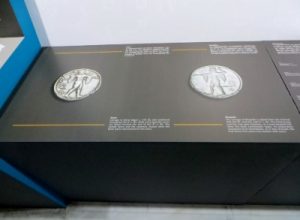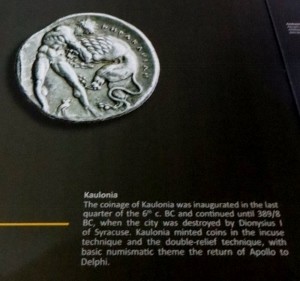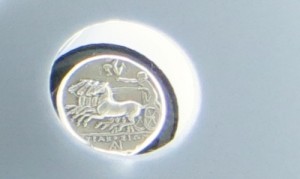
The Greek sensitivity is shown in the unique “The Europe of Greece: Colonies and Coins from the Alpha Bank collection” at the Archaeological Museum of Thessaloniki. The use of coins constituting the principal medium of transactions is explained. The exhibit was extended until October 2015.
I went to experience history, through ancient Greek coinage, during my free time with Dolphin Hellas, Athens tourist group arranged by Uli.“Many centuries ago, the Greeks embarked on a long voyage, leaving behind their birthplace, their homes, experiencing the challenge of the unknown and seeking new homelands on distant shores of the Mediterranean and the Euxine Pontus (Black Sea Coast, Turkey and Russia), said the exhibit’s brochure.

“They put down roots in these lands, came into contact with the local peoples and had a catalytic and multifarious effect both on the place and the people. Concurrently, however, through this process, they participated in shaping Hellenic identity and self-awareness, setting their indelible seal on European culture as a whole. Today, when a new wave of Greeks is inundating Europe in search of a better life, one cannot help but wonder: Are adventure, voyage, escape and hope, but also nostos, the vision of return, the destiny of the Greeks?”

In Unit One, a point highlighted was that “the Mycenaeans (from the Peloponnese not the Minoans of Crete) gave another meaning to long voyages. From the mid 15th B.C., they established trading stations around the rim of the Mediterranean, essentially preparing the way for the systematic colonization of the succeeding centuries.” Artifacts shown include: a black figure krater of Hercules wanderings by painter Sophilos; clay vessel, 856-825 B.C., Eretria Archaeological Museum and coinage.

Unit Two entitled “Colonization: Adventure and Challenge, Identity and Nostos,” shows the first colonization in six B.C. with the collapse of Mycenae, resulting in settlements in Asia Minor and the Aegean. The second colonization to the western Mediterranean and Euxine Pontus was an organized business/trade and acquisition of agricultural lands venture. The Greek colonies founded were in Spain, France, Italy, Albania, Ukraine, Romania and Bulgaria, and shaped the culture of Europe. The exhibit states “the sea was a vital force in Hellenic Civilization. Myths, epics, and heroes were invented on the basis of maritime adventures. Artifacts included: spear points, eighth to seventh century B.C., and coinage from south Italy, ninth century B.C.

They promoted the use of coins already used in Mainland Greece since the sixth century B.C. A creation of a Greek polis resulted. Euboeans and Corinthians were main colonizers. There were strong ties with the metropolis who governed the colony. Sanctuaries and oracles such as Delphi were centers of information and advice on colony planning and shaping a consciousness of a Hellenic identity. Each colony had its own particular culture and coinage. The exhibit focuses on the dissemination of the Greek alphabet, coinage, new crops, Greek habits such as attending the symposium and theater.
The final unit is devoted to “The Greeks and others: New homelands.” This geographical spread included: Southern Italy and Sicily, Southern France, Spain, the Illyrian coasts and the Euxine Pontus. Thirty-nine colonies are featured. Relations between the Greek colonists and the neighboring persons are explored. Coexistence influences were generated. New culture traits were introduced. Cohabitation became possible. The Greeks relations with seafarers and their potential rivals of the Phoenicians and Celts of Western and Eastern Europe are described. “The Celts, who were known as Gauls, were so fearless that their only fear was that the sky would fall down upon their head, said Alexander the Great. Greek luxury drinking vessels of fifth century B.C. were placed as grave goods in the tombs of the Celtic aristocracy…Indomitable warriors…they were engaged as mercenaries throughout the Mediterranean world.” The Irish are their descendants.

“The Greek colonists brought technology and culture from the Aegean to the Central-Western Mediterranean and the Euxine Pontus, settling their indelible seal on the Western world,”states the exhibit. “The best known example is the adoption of the Chalkidian alphabet by the Etruscans (first Italians) and after them the Romans. This alphabet today in the form of the Latin alphabet, is the most enduring and visible consequence of Greek colonization.

The Greek colonization of South Italy is a phenomenon that set its seal on the entire Western world…Sicily was of paramount importance for the Greek colonization. Center of sea lanes controlling channels linking the Adriatic and Tyrrhenian Seas and producer of grain… Coins showed Syracuse had the richest coinage in Sicily and one of the loveliest in the ancient world of sixth century B.C. The quadriga and head of Arethusa influenced the coinage of the Sicilian cities.”
With Greek emigration overseas continuous. One must know the past in order to understand the present.
See all the latest news from Greece and the world at Greekreporter.com. Contact our newsroom to report an update or send your story, photos and videos. Follow GR on Google News and subscribe here to our daily email!



